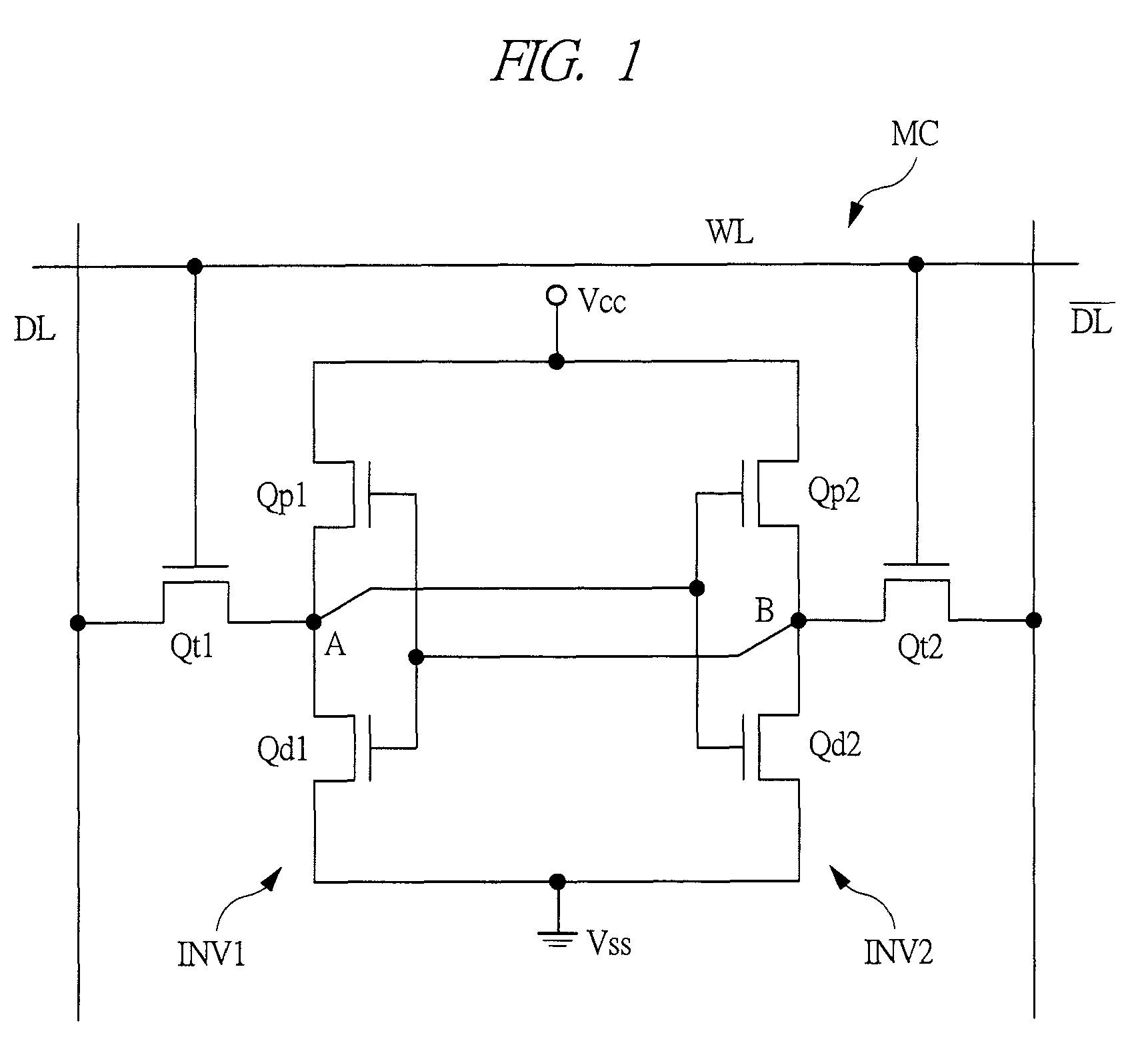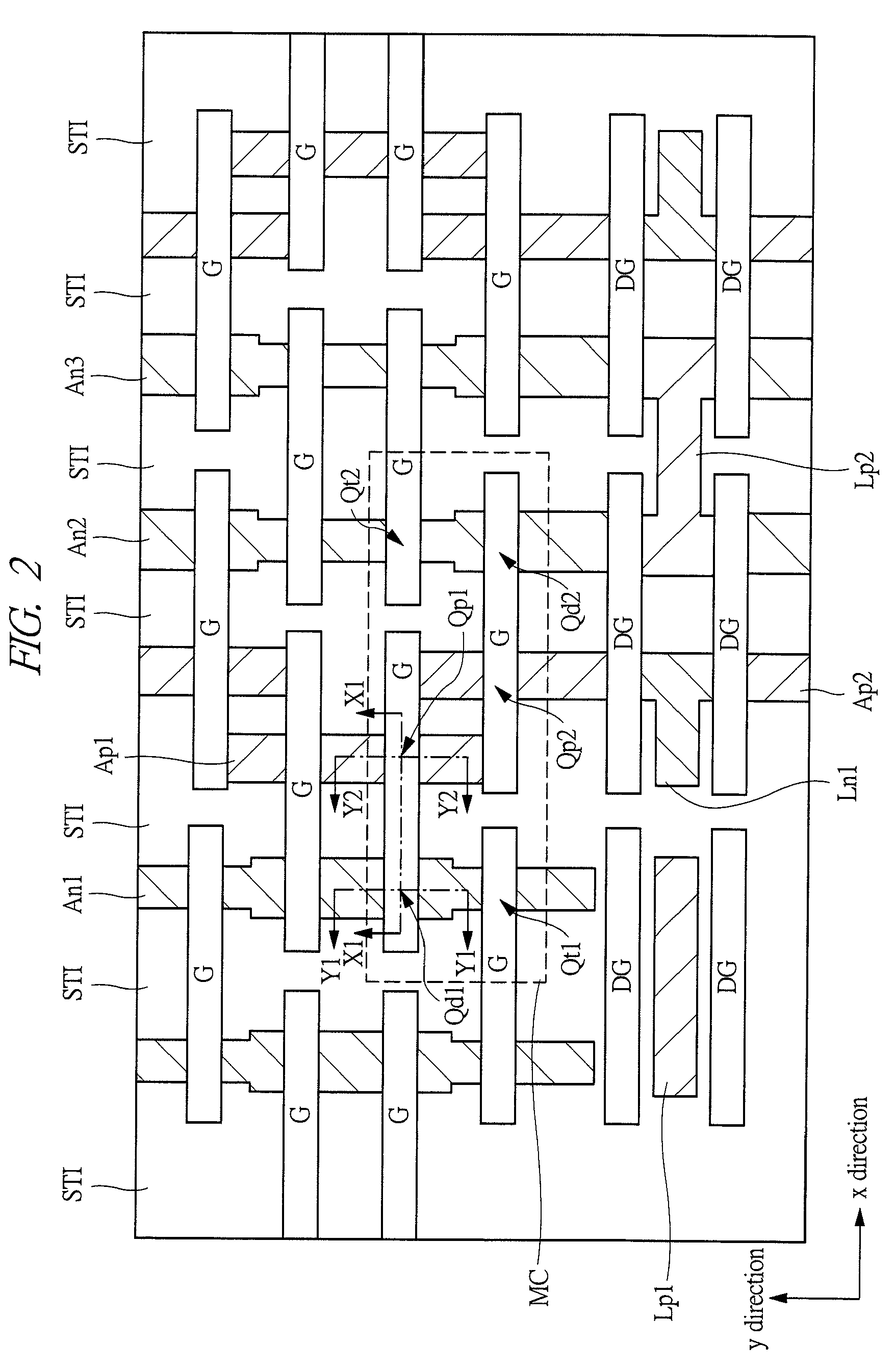Manufacturing method of semiconductor device
a manufacturing method and technology for semiconductor devices, applied in the direction of semiconductor devices, basic electric elements, electrical equipment, etc., can solve the problems of increasing leakage current of misfet, and achieve the effect of reducing leakage current, increasing misfet leakage current, and increasing thickness of gate insulating films
- Summary
- Abstract
- Description
- Claims
- Application Information
AI Technical Summary
Benefits of technology
Problems solved by technology
Method used
Image
Examples
first embodiment
[0086]The first embodiment will be described with an SRAM (Static Random Access Memory) being taken as an example of a semiconductor device. First, an equivalent circuit of a memory cell MC constituting an SRAM will be described. FIG. 1 is an equivalent circuit diagram showing the memory cell MC of the SRAM according to the first embodiment. As shown in FIG. 1, this memory cell is disposed at an intersection between a pair of complementary data lines (data line DL and data line / DL) and a word line WL, and is constituted of a pair of driver MISFETs Qd1 and Qd2, a pair of load MISFETs Qp1 and Qp2, and a pair of transfer MISFETs Qt1 and Qt2. The n-channel MISFETs are used for the driver MISFETs Qd1 and Qd2 and the transfer MISFETs Qt1 and Qt2, and the p-channel MISFETs are used for the load MISFETs Qp1 and Qp2.
[0087]Of the six MISFETs constituting the memory cell MC, the driver MISFET Qd1 and the load MISFET Qp1 form a CMOS inverter INV1, and the driver MISFET Qd2 and the load MISFET ...
second embodiment
[0166]In the second embodiment, the example where the diffusion of an element by an element supply film is performed after forming an offset spacer on a sidewall of a gate electrode will be described. Since the manufacturing method of a semiconductor device according to the second embodiment is almost the same as the manufacturing method of a semiconductor device according to the first embodiment, the description will be made while placing an emphasis on the difference therebetween.
[0167]The process from FIG. 12 to FIG. 15 is the same as that of the first embodiment. Subsequently, as shown in FIG. 31, a silicon nitride film is formed on the whole surface of the semiconductor substrate 1S. Then, the silicon nitride film is anisotropically etched to form offset spacers 20 on the sidewalls of the gate electrode G1 (including the silicon nitride film 5 to be the cap insulating film) and the sidewalls of the gate electrode G2 (including the silicon nitride film 5 to be the cap insulating...
third embodiment
[0175]In the third embodiment, the example where the first insulating film exposed on the semiconductor substrate 1S is removed after forming a gate electrode and a silicon oxide film is formed in the region where the semiconductor substrate 1S is exposed, and thereafter, an element is diffused from an element supply film into the first insulating film will be described. Since the manufacturing method of a semiconductor device according to the third embodiment is almost the same as the manufacturing method of a semiconductor device according to the first embodiment, the description will be made while placing an emphasis on the difference therebetween.
[0176]The process from FIG. 12 to FIG. 15 is the same as that of the first embodiment. Next, as shown in FIG. 34, the exposed first insulating film 2 is removed. By this means, the first insulating film 2 is formed only just below the gate electrode G1 and the gate electrode G2. Although the surface of the semiconductor substrate 1S is ...
PUM
 Login to View More
Login to View More Abstract
Description
Claims
Application Information
 Login to View More
Login to View More - R&D
- Intellectual Property
- Life Sciences
- Materials
- Tech Scout
- Unparalleled Data Quality
- Higher Quality Content
- 60% Fewer Hallucinations
Browse by: Latest US Patents, China's latest patents, Technical Efficacy Thesaurus, Application Domain, Technology Topic, Popular Technical Reports.
© 2025 PatSnap. All rights reserved.Legal|Privacy policy|Modern Slavery Act Transparency Statement|Sitemap|About US| Contact US: help@patsnap.com



